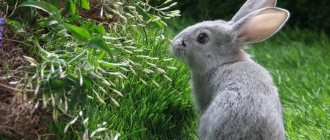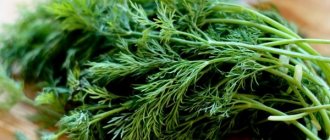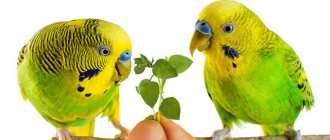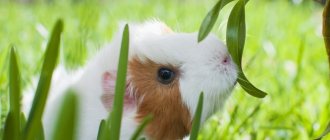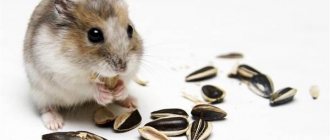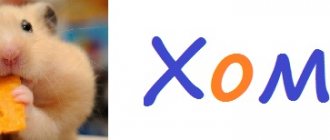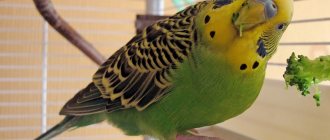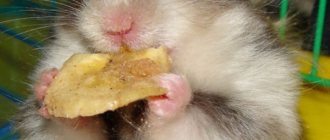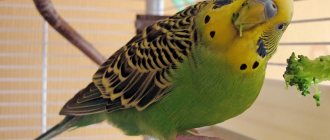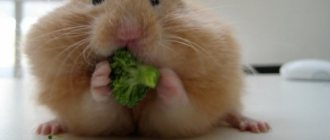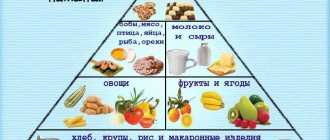Fresh and juicy greens should definitely be on the hamster’s menu. This is an important component of balanced nutrition, since by consuming it, the pet receives many of the substances it needs. But not all vegetation is suitable. There is one that is inedible for dzhungariks and Syrian hamsters. In order not to harm your pets, you need to learn to understand herbs that can be not only beneficial, but also poisonous for your hamster.
I don’t think it makes sense to write separately about Djungarian and Syrian hamsters. There is no difference for them in this regard. The Syrians will also gnaw the grass that can be given to dwarfs with pleasure. With poison, everything is the same.
Can hamsters be given grass and why?
Hamsters are steppe animals. They encounter grass in the wild and eat it with pleasure. Therefore, the question of whether a hamster can eat grass does not even arise in anyone’s mind. But what kind of grass you can give to your Djungarian or Syrian is a more correct question. Let's start with it.
It is not only possible, but also necessary to offer the animal any vegetation, and primarily that which is consumed by people themselves. However, you must always remember that he is unlikely to “like” some vegetation, for example, onions, but the hamster will eat lettuce leaves and many other varieties of herbs with pleasure.
How to stock up on greens?
It is best to cut grass for fluffy at your own dacha or in natural conditions (meadow, field). It is necessary to ensure that the gathering place is away from large populated areas, busy highways and businesses.
In summer, problems with greenery usually do not arise; there is a lot of it everywhere. In winter, it is difficult to find healthy herbs: they are expensive in stores, and it is not known what pesticides and nitrates they contain. Therefore, plants can be frozen or dried in the shade and stored in jars. Frozen weed retains more nutrients when thawed in the refrigerator.
By the way, in winter you can grow fresh grass right on your windowsill! To do this, you will need a long box, soil or sawdust, and lawn seeds.
Why give grass to hamsters, what is useful in it
The animals happily feast on various vegetation. It is recommended to give succulent food in fairly large quantities: they contain water, which is necessary for all animals, and many other components:
- Proteins (serve as the building material of cells and tissues) and carbohydrates (saturate the body with energy).
- Lots of vitamins (B vitamins, vitamins A, E, C and carotenoids). These components increase the body's ability to resist various diseases.
- Microelements, for example, iron, potassium, zinc, selenium, magnesium, calcium, phosphorus.
- The fiber found in greens helps process food and has a positive effect on your pet’s digestive system. Serves as medicine for him.
Yes, it looks edible.
More! There are varieties of herbs that can be used as therapeutic and prophylactic agents for deviations in the health of a hamster. For example, plantain has disinfecting properties, and knotweed relieves inflammation and has a diuretic effect.
The animal must always have a sufficient amount of fresh grass. But you need to pay attention not only to its types, but also to treat your hamster only with high-quality and healthy green food.
Preparation for future use.
Picking herbs is the easiest way to provide your pet with healthy, succulent food. However, dandelion leaves lose their value closer to autumn, become dense, hard, and more bitter. What should you give your pet during the long autumn-winter period? You can buy sprouted oats or try to grow your own grass on the windowsill. Or you can prepare tender young grass for future use. In spring, greens are packaged into small portions and sent to the freezer. Freezing preserves much more beneficial properties of the plant than drying. This way the animal will be provided with high-quality feeding all year round without extra costs.
What herbs can hamsters eat?
In order for greens to only benefit animals, you need to know well the types of herbs that will benefit them:
- Various greens from the garden, for example, lettuce, beet or carrot tops, parsley, etc.
- Weed grass. It can be wheatgrass, nettle before flowering or dandelion, but the leaves should not have veins.
- Forage crops. These include sprouted wheat or oats, clover, and alfalfa.
- Leaves from trees. You can safely give your pet leaves from birch, maple, apple, peach, cherry, apricot, peach, grape and others.
Most of the listed plants can be used for daily nutrition. They have different mineral and vitamin composition and taste, so it is better to combine them or give them in turn.
Is it possible to give a hamster regular grass from the street?
Plants must be collected as far as possible from various industries and roads with heavy traffic. It is best to use the one that grew in your garden without the use of pesticides and other chemicals. Before giving vegetation to a rodent, it must be washed well under running water to remove all dirt, bacteria and worm eggs.
You cannot collect grass near parking lots. It contains a large amount of soot and heavy metal salts. It can harm your pet.
Is it possible to feed a rodent weeds?
Fluffy pets enjoy eating the following weeds:
- Dandelion. Only leaves are suitable for feeding. In addition to food, they are also used to prevent the development of eye diseases. In addition, due to the high presence of vitamin E, dandelion leaves, when consumed regularly, make the hamster's coat more shiny. This vitamin also increases appetite and promotes rapid healing of wounds. Dandelion tastes bitter, so the central vein of the leaves is removed and a small amount of this plant is given.
- Nettle is not as beneficial as dandelion, but it contains iodine, which is very low in other herbs. It is advisable to feed only young shoots.
- Wheatgrass has an immunomodulatory and antitumor effect on the body of rodents. When fresh, it is placed in a cage during colds.
- Sagebrush. This plant has many beneficial properties. The main ones are anti-inflammatory, diuretic and sedative effects. Wormwood also helps improve intestinal motility, stomach and gallbladder function. Some veterinarians prescribe this herb to animals as a remedy. Wormwood can be placed near the cage. The smell of wormwood will repel fleas from the animal, but this rich smell will not harm it at all.
We combine business with pleasure. Tasty, beautiful, healthy.
Should you give your hamster greens from your garden?
It is possible and even better to give hamsters greens from the garden, as they are tasty and at the same time healthy for them, especially when the owners grow them without using pesticides.
The most useful plants for hamsters:
- Dill and parsley. Spicy greens contain a lot of vitamin K, C and carotenoids. If it is regularly included in the diet of hamsters, their risk of developing cataracts will be significantly reduced, the immune system will be strengthened, which will increase the body's resistance to diseases. Greens contain many minerals that have a beneficial effect on the condition of teeth. These are calcium, magnesium, phosphorus, etc.
- Celery. In addition to vitamin C, it contains B vitamins. This spicy herb is considered a good source of magnesium, phosphorus and sodium. Some pet owners doubt whether to give celery to their pets, because it has a rather specific aroma and taste. This is not scary for hamsters, but you should not offer them celery often. The best option would be once every 7-10 days.
- Carrot tops. This vegetation is allowed to feed the fluffies constantly. It contains substances that help avoid colds, heart disease, including heart attack, and diabetes. The green part is not as sweet as carrots, but it contains 5 times more vitamin C. The tops also contain a large amount of calcium, which helps strengthen bones and teeth.
- Salad leaves. This is perhaps the favorite treat of hamsters. The composition of useful components in the salad is the same as in parsley, but in smaller quantities. Peking salad can also be given to pets, but in small portions.
Cat grass for dwarfs and Syrian hamsters
The classic “cat” grass is wheat. Wheat germ contains vitamins B6 and E, riboflavin, pantothenic acid, manganese, zinc, and niacin. The length of the sprouts should not exceed 30 cm. Otherwise, substances toxic to rodents will begin to appear at the ends of the grass.
You can also use oats. It requires the creation of a greenhouse for germination.
Medicinal herbs
Most green food not only feeds the animal, but also treats it. Hamsters often exhibit various health problems. If any disease occurs, you can try using remedies from a natural pharmacy:
- Rose or rose petals. With their help you can strengthen your hamster's immunity. They also promote faster healing of wounds. Rosehip leaves are considered especially useful, but the thorns must first be removed from them.
- Plantain. Plantain leaves help heal wounds and have an antimicrobial effect. Including plantain in your pet's diet will help heal wounds in the mouth, which often appear when feeding rough food.
- Knotweed. This plant is distributed everywhere. It relieves inflammation and has a diuretic effect. This is one of the favorite dishes of wild rodents.
- Snooze. Helps strengthen the body's defenses, destroys pathogenic microbes, prevents the development of tumors, has a beneficial effect on joints, and provides the body of fluffies with necessary minerals and vitamins.
Proper diet: composition
The basis of the rodent diet is cereals. It is advisable to give fresh and dried grass every 2 days, because in the steppe greens are the hamster’s main food in the summer. Vegetables and fruits are a small part of the diet, no more than 5% of food consumed. To be healthy, rodents need animal protein, which makes up a small proportion of their diet. Increasing the amount of meat and dairy foods is useful during pregnancy or breastfeeding.
Nuts and seeds are a treat, they should be given a little and no more than 2-3 times a week.
What grass should not be given to hamsters and why
Not all plants are suitable for inclusion in the menu of dwarf hamsters and Syrian hamsters, even if they are edible for humans. Some plants can cause allergic reactions and stomach irritation. There are also those that are completely poisonous to hamsters.
The following herbs should not be given to furry pets:
- Sorrel. It contains a large amount of oxalic acid, which leads to allergies and irritation of the gastric mucosa.
- Potato tops are rich in solanine. This substance is a strong poison for animals. Leaves of eggplants, peppers and tomatoes. They also contain a component that is dangerous to them - a glycoside. Your pet may even die from it.
- Onions and garlic cause allergies. But, most likely, the fluffy will not eat these plants because of the strong and specific aroma.
- Mint and lemon balm contain essential oils that quite often cause allergies. Therefore, these plants do not need to be added to the diet even in small quantities.
- People use St. John's wort as a medicinal plant. But for these animals it poses a danger.
Have you read it?
Do you remember? So eat your own tops. The list of plants dangerous to domestic rodents is quite long. It includes indoor, wild and garden crops. Therefore, you should not feed your hamster fresh grass unless you are sure that it will not harm your health.
Prohibited plants
In addition to healthy greens, there are herbs that fluffies should not eat. Everyone knows that sorrel is very tasty and rich in vitamins, but small rodents should absolutely not eat it. It is too acidic and can corrode the mucous membrane of the digestive tract or cause allergies.
Prohibited herbaceous plants also include:
- potato tops (and sprouts). Not recommended due to the high content of the alkaloid solanine, which is poisonous to hamsters;
- white cabbage. Weakens the hamster's delicate stomach, causing diarrhea;
- garlic and onion feathers contain strong-smelling essential oils that provoke allergies. The hamster himself will not eat them because of the sharp bitter taste;
- mint and lemon balm are also strong allergens.
It is strictly forbidden for domestic rodents to collect grass from the street, because it is covered with a layer of dust, soot and heavy metals, poisonous to furry babies.
What's the result?
Yes, friends, to paraphrase a famous advertising slogan - not every weed is equally beneficial. While I was collecting material for the article, I was also surprised by some facts. It used to be like this: he went out into the yard, picked some grass and put it in a cage. What my dzhungarik liked, he ate, what he didn’t like, he didn’t eat. Accordingly, in the evening I threw it away so that it would not dry out and rot. Naturally, I didn’t give him any nettles, because I wouldn’t voluntarily climb into these thickets with my bare hands. It turns out in vain... Lack of iodine in the body causes problems with the thyroid gland, not only in hamsters, but also in people. Yes, I know about nettle cabbage soup, but sorry, it’s not my thing. Do whatever you want with me. And now I’m thinking... Maybe it’s for nothing that I don’t eat them?
Nothing beautiful is alien to us.
In the wild, how do hamsters distinguish beneficial grass from harmful grass? Trial and error? After all, the hamster itself is the size of a child’s fist. Does he need much? It seems that they are mistaken only once... Or, option No. 2 - during evolution, only those who can calmly digest 90% of everything that is in their habitat have survived.
What do you think of it? Tell me?
Basics of nutrition at home
Rodents are omnivores and will eat anything that is offered to them. Unlike wild animals, domestic animals live up to 3 years thanks to a balanced diet. Special dry food is suitable for this. You can cook it yourself. The food includes what these animals eat in the wild: fruits and grains.
Special dry food is suitable for feeding hamsters.
List of prohibited foods
sssssss hamster many substances in food that are harmless to humans are poisonous to him:
- citrus fruits and other sour fruits and berries: pomegranate, kiwi, pineapple, mango, sea buckthorn, barberry;
- fatty foods: milk, sour cream, butter, kefir, cheese;
- products containing starch: potatoes, sausages, sausages;
- almond;
- heavy food: mushrooms, flour products, beans, cabbage;
- sweets: honey, chocolate, muesli;
- unpeeled seeds;
- onion garlic;
- sorrel;
- mint;
- salt and spices;
- peach, cherry, apricot pits;
- raspberries;
- persimmon;
- avocado;
- watermelon;
- melon.
Due to their small size, hamsters should not be given citrus fruits.
LiveInternetLiveInternet
—Categories
- 100 beauty recipes (53)
- Health (11)
- facial care (9)
- hairdresser (7)
- beautiful legs (4)
- hand care (1)
- Repair (18)
- serious crafts (8)
- Dacha (6)
- Easter (3)
- Interior (2)
- might come in handy (45)
- tasty treats (268)
- fast and tasty (34)
- cook in pots (8)
- Lenten dishes (2)
- from dough (61)
- for a picnic (17)
- dumplings (5)
- appetizer salads (49)
- salt and pickle (13)
- cakes (15)
- Embroidery (5)
- knitting (266)
- adults (8)
- kids (6)
- knitting for girls (25)
- knitting for teenagers (25)
- For yourself (12)
- useful tips (9)
- belongings (22)
- for the soul (109)
- cinema (15)
- books (4)
- crochet for beginners (17)
- New Year's (56)
- New Year's menu (19)
- Handicrafts (14)
- festive (3)
- By city and country (2)
- usefulness (60)
- useful tips (17)
- pleasantness (34)
- handicrafts (193)
- Little things in life (26)
- decoupage (17)
- For dolls (22)
- quilling (7)
- alterations (14)
- crafts (47)
- we sew ourselves (63)
- adults (6)
- for home (6)
- teenagers (2)
- Prichindals (14)
—Quote book
Learning to paint gingerbread cookies❄❄❄ To make icing, you need.
Another simple recipe for preparing eggplants for the winter is to combine them with...
Clover is popularly known by many names: trefoil, honey stalk, eryngium. .
—Search by diary
—Subscription by e-mail
—Interests
-Statistics
What should you not feed hamsters?
We have already written that domestic hamsters should absolutely not be given
any exotic fruits, hot, salty, peppery or too sweet, as well as fatty foods, for which the animal’s small digestive system is not designed at all.
This means that honey, any sweets, kozinaki, ice cream, halva and shortbread dough are contraindicated for a hamster: for a pet this is a slow-killing poison. The rodent's diet should be free of any milk, butter, cream, kefir and sour cream. Cabbage, fried meat, chocolate products, pasta, bread, breadcrumbs are contraindicated for your pet, as they contain an ingredient that is dangerous for the hamster. Yes, yes, don’t be surprised, hamsters should absolutely not be given bread, only grain.
Naturally, garlic, hot peppers, onions, and sorrel should not be given to a rodent. Do not forget about melons and watermelons, as well as apricot or cherry pits, which contain acid that is harmful to the hamster.
Every time, make sure that the hamster eats only fresh, unspoiled food and feed, ripe fruits and vegetables, and has the required amount of fresh water. This is the only way your playful pet will delight you and your family for a long time with its cheerfulness, activity and healthy appearance!
Apples are one of the most popular fruits in our latitude. We meet him almost every day in shops, bazaars, and in our own garden. It is a relatively cheap, easily accessible, tasty food for many pets.
Traditional plastic carrier
Perhaps the most common way to move small animals. Very well suited for long-distance travel, but in a car (and especially on a bicycle) a bulky plastic box is not very convenient.
Among the advantages, we note excellent breathability, ease of cleaning and maintenance, the ability to organize meals while traveling, hygiene, strength and durability.
The disadvantages are determined by the need to allocate space for storing this box and, of course, the outdated design. It is necessary to have such a device in stock, but it is not very suitable for short-term forays outside the city.
Cost – 1,146 – 2,137 rubles.
Choosing dry food
Instead of self-composed grain mixtures, you should prefer ready-made industrial food produced under brands specializing in food for rodents. Their composition includes the amount of nutrients, mineral and vitamin supplements necessary to maintain the health of the hamster. In addition to the traditional components of dry food, the composition of some immediately includes dried vegetables, dried fruits and other elements of a balanced diet.
For your pet, you need to purchase high-quality food produced by trusted companies. If possible, you should avoid cheap feeds that are classified as economy-class products. It is best to buy food intended specifically for Djungarian hamsters, since mixtures for other varieties may contain prohibited components that will have to be pre-selected manually.
Dry food takes up 80-90% of a hamster's daily diet. At the same time, the daily food requirement for a fluffy is one tablespoon. Despite all the gluttony of a rodent, its proper, complete feeding does not require large expenses.
Possible problems in the diet of dzhungarika
Genetic predisposition to obesity and diabetes are the main health risks for pet hamsters. But if you follow the recommendations for proper feeding, problems can be avoided. To maintain your pet's normal weight, you need to install a wheel in its cage, let the hamster out for walks more often and play with it.
In case of illness, symptoms appear in the animal immediately: lethargy, lack of appetite, wet tail, wet nose, diarrhea, bloody discharge.
Hamsters of this breed suffer from many diseases. Some of them are related to poor nutrition:
- With constipation, the pet loses its appetite, makes squeaks when defecating, and there is less excrement in the cage than usual. In this case, you need to add more fiber to the hamster's diet or a drop of vegetable oil to the dry food.
- Some foods cause bloating. For example, you should not give your pet white cabbage and black bread. For flatulence, a decoction of dill is offered.
- Diarrhea may be the result of eating some spoiled product or an infectious disease.
- If your hamster is obese, it will become short of breath. Diet will help correct the situation.
Some symptoms may overlap, so it is best to contact your veterinarian to determine an accurate diagnosis.
